Clinical Center News
National Marrow Donor Program looks to enroll federal employees in registry
NIH staff have dedicated their lives to advancing human health. A recruitment campaign to enroll federal employees in a marrow donation registry is asking them to gift a different kind of life to those in need.
The Health Resources and Services Administration hopes to recruit 5,000 federal employees to the Be The Match Registry this year by providing funding to cover their tissue typing.
As the only National Marrow Donor Program donor center on a federal campus, the Clinical Center Department of Transfusion Medicine is at an advantage to register these possible life-savers.
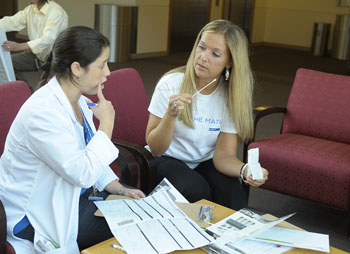 |
|
Sarah Pogue (right) enrolls Shanna Bernstein in the Be The Match Registry for marrow donation. Some simple paperwork and a cheek swab are the only steps to sign up.
|
Leukemia is the most common disease for which a donation of marrow—tissue from inside the bone that produces new blood cells—can mean remission. A donor must match on a number of markers. While some patients can turn to a family member for a match, 70 percent must depend on someone unrelated.
Joining the Be The Match Registry does not guarantee that one will be asked to donate, said Sarah Pogue, senior coordinator of the NIH Marrow Donor Program. Enrolling means if identified as a perfect match for a patient in need of a transplant, you agree to consider donating marrow or stem cells.
"You are not only giving someone a second chance at life, you are providing hope and reassurance to the patient and his or her family that regardless of the outcome of the transplant, everything that could have been done to extend the patient's life was done," Pogue said.
The CC held an event on August 11 to enroll employees in the Be The Match Registry, a quick and painless process. About 100 potential donors signed up.
Shanna Bernstein, a clinical research dietitian with the CC Nutrition Department, happened to walk through the area on the Hatfield Building seventh floor.
"I work on an oncology floor. It seems really relevant and important," she said. "If you work here, I don't see why you wouldn't join."
The process of donation is noninvasive, too. There are two types—peripheral blood stem cells (PBSC) or marrow donation.
PBSC donation is nonsurgical. A drug increases the number of blood-forming cells in the marrow and releases them into the circulation. Blood is removed through a needle in one arm and run through a machine to remove these cells. Blood is returned through the other arm, and the blood-forming cell count returns to normal levels in a few days.
Marrow donation is a surgical outpatient procedure done under anesthesia. Doctors withdraw liquid marrow from the back of the donor's pelvic bone.
The August recruitment event was held to benefit two Koch sisters who have DOCK8 deficiency—a genetic disorder discovered at NIH (see story below). A gene defect predisposes them to viral/fungal/bacterial infections and lymphomas.
The Department of Transfusion Medicine hopes to hold more recruitment events in the near future. To join the Be The Match registry, visit the department or call 301-496-0572.
Back to Top
Family enrolls marrow donors as they wait for their own
As a mother with two daughters in need of a stem cell transplant, Tammy Koch is proactive and hopeful.
Her girls Kelsey and Karly were diagnosed at the NIH with a defect in the DOCK8 gene. The disorder makes them more susceptible to deadly infections and cancers such as lymphomas.
A transplant from a marrow donation is the girls' best hope for recovery, but neither their parents nor their two sisters or two brothers are matches. To find a possible donor for Kelsey and Karly, ages 22 and 16 respectively, and help others in need of a transplant, their mom has organized a donor registration campaign in their home state of Indiana.
The sisters were both ill from birth with a puzzling variety of symptoms—ear, sinus, and lung infections; rashes; hair loss. They were tossed between doctors and given dead-end diagnoses, such as an infection or allergy.
"It was very frustrating," Kelsey said. "I would want to do things with my friends, but I always had a doctor appointment or didn't feel well."
Eventually, they were told that the girls seemed to have Job's syndrome, an immune disorder. Through her sister who lives in Maryland, Tammy heard of the NIH and Kelsey and Karly were enrolled in a protocol under Dr. Steven Holland, chief of the Laboratory of Clinical Infectious Diseases, National Institute of Allergy and Infectious Diseases, and Dr. Alexandra Freeman, staff clinician.
Tammy remembers Holland telling her, "Even if this is not what they have, we will stick with it until we figure it out."
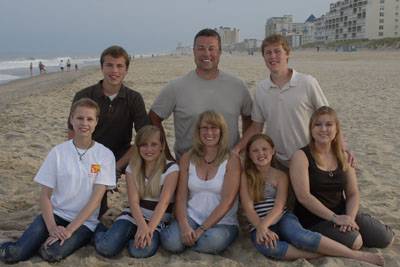 |
|
The Koch family—(front, from left) Karly, Konner, mom Tammy, Kassidy, and Kelsey, and (back, from left) Trent, dad Tracy, and Tyler—are searching for marrow donor matches for Karly and Kelsey, who were diagnosed at the Clinical Center with a defect in the DOCK8 gene.
|
"That gave me a great hope," she said.
Part of a subgroup of patients diagnosed with Job's syndrome who did not present with the syndrome's normal symptoms, the Koch sisters contributed to the identification of DOCK8 deficiency. There is still much to learn about the gene's function, so studies continue.
What is known is that the disorder can lead to a dire outcome. Kelsey and Karly need a stem cell transplant and have been searching for a marrow donor since last summer.
"I wasn't going to wait for someone to show up, I took a proactive approach," Tammy said. She ran a drive in November—appealing to local business and clubs and advertising on the radio—that enrolled 1,000 new potential donors.
Kelsey is a student at Ball State University and spoke in classes encouraging her peers and professors to register as a potential marrow donor.
"They were stunned that there are people in their community who they can help. I told them they might not save my life but could save someone else," she said.
Karly's need was amplified when she was diagnosed with a rare lymphoma in November. While they enroll more marrow donor registrants and wait for matches, the Koch family focuses on living each day.
"I think the more that people are educated and learn how simple it is to join the registry, the more people will sign up," Tammy said. "You can save lives."
Back to Top
Association noted between virus and chronic fatigue
Experts from the Clinical Center, the Food and Drug Administration, and the Centers for Disease Control and Prevention spoke to close to 100 participants on a teleconference for media August 23 to discuss a study that examines the presence of murine leukemia virus-related viruses (MLV) in the blood of patients diagnosed with chronic fatigue syndrome (CFS) and of healthy donors.
Their findings—published in Proceedings of the National Academy of Sciences (PNAS)—report that MLV-like gene sequences were identified in 86.5% of the CFS patient samples compared to 6.8% of healthy donor samples.
"It is an association, and we have to emphasize that we have not proven causality for this agent," said Dr. Harvey Alter, chief of clinical studies and associate director for research, CC Department of Transfusion Medicine.
Joining Alter at the teleconference were the study's principal investigator Dr. Shyh-Ching Lo, director of the Tissue Safety Laboratory Program in the FDA Office of Cellular, Tissue and Gene Therapies; Dr. Celia Witten, director of the FDA Office of Cellular, Tissue and Gene Therapies; Dr. Hira Nakhasi, director of the Division of Emerging and Transfusion Transmitted Diseases, FDA Office of Blood Research and Review; and Dr. Steve Monroe, director of the CDC Division of High-Consequence Pathogens and Pathology.
MLV are retroviruses known to cause cancer in certain mice. In 2006, investigators found that a type of MLV, called xenotropic murine leukemia virus-related virus (XMRV), could potentially infect humans and possibly cause prostate cancer. In 2009, a study in Science (Lombardi et. al) reported finding XMRV in a high percentage of CFS patients and a small percentage of healthy blood donors.
However, other studies conducted in the United States, the Netherlands, and the United Kingdom reported no evidence of XMRV or other MLV-related viruses in CFS patients.
"We think it's more likely in the patient populations than in the laboratory testing," Alter said of the discrepancy. "Chronic fatigue syndrome is just that, a syndrome, and not a specific biopsy-proven diagnosis. This constellation of symptoms and signs may be due to multiple different agents or other non-infectious causes."
The PNAS study—with authors from the FDA Center for Biologics Evaluation and Research, the CC, and Harvard Medical School—tested blood samples collected from the New England area in the mid-1990s from 37 patients diagnosed with CFS, as well as samples from 44 healthy blood donors collected in the NIH Blood Bank between 2003 and 2006. Follow-up samples were collected from eight of the CFS patients in 2010, and seven of these again tested positive for MLV-like gene sequences.
"The possibilities are that this is just an association and has no causal role in the disease, or that it has a causal role in some of the patients and that other cases of CFS have other etiologies. At this point, we just don't know," said Alter.
The FDA, the NIH, the CDC, and other scientific institutions are conducting studies to verify the capabilities of the tests used by the different laboratories for the detection of XMRV or MLV-related viruses in blood. These studies are intended to develop and standardize a highly sensitive and specific test for MLV-related agents to better study its association with disease, as well as the possibility that XMRV/MLV can be transmitted to blood or tissue recipients.
At present, the FDA does not have a donor policy specific to XMRV or MLV as there is currently no evidence that XMRV or MLV are transmitted by transfusion in humans. However, FDA regulations require that donors be in good health at the time of donation.
Back to Top
CC fellow stars in documentary on humanitarian group
Before beginning a post-doctoral fellowship with the Clinical Center Department of Bioethics, Dr. Chiara Lepora led a Doctors Without Borders/Medecins Sans Frontieres (MSF) mission in Monrovia, Liberia. Her experience and that of others with the international medical organization was featured in an Academy Award-nominated documentary, Living in Emergency.
Lepora sat with CCNews to discuss her humanitarian work, the making of the film, and the ethical challenges she faced in both circumstances.
Living in Emergency is touring the country on an on-demand basis. Visit http://www.livinginemergency.com [disclaimer] for more information on how you can view the documentary.
 |
|
Dr. Chiara Lepora radios to her MSF team in Monrovia from Lofa County in northern Liberia.
|
CCNews: Why did you join MSF?
Lepora: I was working as a doctor in Italy, and I think, like lots of doctors in Western societies today, I was a bit unsatisfied by the role that doctors play in big hospitals.
What was your initial experience like?
My first mission was in Angola, just at the end of their 30-year-old civil war. We were the first team that was able to access the so-called gray zone, the area between the two fighting factions that had no humanitarian access for ages. It was surely shocking to see the level of famine. There was a huge crisis, and some people did not see a doctor for probably all of their life.
How did you come to lead the Liberian mission?
I'd been working as a field physician for two years, and then I decided to do a master's in tropical medicine and international health. I started working again with MSF, but more in a coordination position, setting up a program and managing it. This required being able to evaluate the needs of a population, to adapt a program to those health needs and to provide the means necessary to run it to the medical teams—the expatriate doctors, nurses, logisticians, administrative staff, and especially, the national staff.
What were the conditions like that you were working in?
In Monrovia, in the capital, like in most of the country, the whole medical system was completely disrupted by the war. That included structures like hospitals and the presence of drugs, but also, especially, the lack of health staff, because the majority of doctors who were in the country left during the war or died. So the amount of national staff, of doctors in Liberia, left when we were there was so limited that it was impossible for them to take care of the needs of the whole population. And those were really normal needs like you would have here: hypertension, appendicitis, women having to deliver.
How did filming the documentary go?
I think they came for two weeks, and I have to say I don't remember a lot of them being there. The agreement was that they were supposed to ask the consent for anything and anybody that they were going to film and that they were not going to somehow jeopardize any medical intervention. After that, we just all said, ‘Look, we have a lot to do, we have a lot to think about, more important things. You do your work; you let us do ours.' And that's what happened.
How did the patients react to their presence?
We had only a few patients who said that they didn't want cameras or anything. In general, people were cooperative. Patients, as much as the medical staff, everyone had more important things to concentrate on. And the type of environments where we found ourselves working are not necessarily as used to the effect of TV as it would be here, so people were not as concerned.
What conversations were held about ethics of allowing filming?
We really wondered whether just the fact of asking, ‘Is it ok with you if the camera comes in?' was enough. If it's a doctor asking them they might think its important for the doctor and therefore its important for their medical care. So we tried to make sure that it was the film crew asking separately and that it was made clear that it had nothing to do with the medical care happening.
Why is it important for this story to be told?
There are aspects of showing those things that are extremely positive. For example, an effect of the film showing is an increase of American doctors asking to work with MSF, which is something that MSF needs all the time.
What brought you from Liberia to Bethesda?
I started thinking about studying bioethics because I had way too many questions and not enough answers, and I was suffering the fact of having to make decisions all the time without knowing if those decisions were right or wrong.
What were some of the questions you had?
Probably one of the most common is the issue of resource allocation. I think we tend to think the problem of resources is about money, for example, not having enough drugs or not having enough ventilators or things like that. In my experience, MSF is a well-known medical organization and it tended to avoid those types of problems, to make sure that drugs and materials are commensurate to the needs. But still there was the problem of human resources. Having only one doctor for 250 patients, you have to make choices about who needs to be seen first and who needs to be sent home one more day, which are really heavy, heavy choices.
Has the Department of Bioethics helped you find some answers?
The department and all the colleagues here really allow me to think about some of the difficult situations I've worked in from a distanced perspective while drawing on my experience.
Back to Top
Shot of truth about the flu vaccine
In 2008, the Clinical Center Medical Executive Committee mandated that all staff who have patient contact—nurses and doctors but also clerks, housekeepers, and others—must be vaccinated against influenza or complete a declination form.
The mandate caused a dramatic rise in flu vaccination among NIH staff. Still, close to 11 percent of required staff (both NIH employees and contractors) declined the seasonal flu vaccine the last two years, and 14 percent declined the H1N1 vaccine last year. Staff who decline must give their reason for declination.
Past studies have shown in years when flu strains in the vaccine match well with the strains circulating in the community, the vaccine can reduce the chances of getting flu by 70 to 90 percent in healthy adults, said CC Deputy Hospital Epidemiologist Dr. Tara Palmore.
The vaccine may be somewhat less effective in elderly persons and very young children, but vaccination can still prevent serious complications from flu. In healthy adults younger than age 65, the flu vaccine can also prevent lost work days and unnecessary doctor visits and antibiotics. Hospitalized patients who are ill or immunocompromised, though, do not usually mount effective immune responses to the flu vaccine, so vaccination is not enough to protect them from getting flu.
The most common reason for declination is concern about side effects. Minor consequences such as soreness of the arm or inflammation at the vaccination site are relatively common, but serious or lasting side effects are rare.
The discomfort of vaccination is minor compared to the proven benefit that flu vaccination of health-care workers has, said Palmore.
"Flu vaccination of health-care staff saves patient lives. That has been shown repeatedly," she said.
For example, a study in the Journal of Infectious Diseases (Potter, 1997) showed a statistically significant reduction in patient mortality among a population of patients in long-term care facilities when health-care workers were vaccinated against influenza.
Many people who have the flu don't realize they have it, Palmore said. Symptoms may be mistaken for those of a cold, but if immunocompromised patients contract the virus it could have more severe consequences.
Palmore wants to set the record straight on more myths about the flu vaccine.
"A misconception cited by a number of people was that they could get flu infection from the vaccine. That is not possible because it contains only killed virus."
This year the product contains agents to address the seasonal and H1N1 flu.
Well-publicized adverse reactions have caused unnecessary anxiety about the vaccine, Palmore said. The 1976 swine flu vaccine was associated with cases of Guillain-Barre syndrome, a paralyzing neurologic response that is usually reversible. "The rate of Guillain-Barre syndrome associated with flu vaccination is miniscule —one in one million vaccinees—and most patients recover completely," said Palmore.
Last year, some children in Australia experienced fevers and febrile seizures after vaccination with one specific company's flu shot. NIH has not purchased that vaccine.
In contradiction to the fears of contracting a more serious disorder from the flu vaccine, some have declined vaccination on the basis that even if infected with the flu, they will likely recover without incident. As health-care workers, however, Palmore said, staff should make the safety of their patients a priority.
A vaccine clinic for patient-care staff only will be held on the Hatfield Building seventh floor from September 20 through October 1, including select times for first, third, and weekend shifts. Qualifying employees and contractors will be notified by e-mail that they fall under the mandate. If you do not receive an e-mail identifying you as a health-care worker with patient contact, please do not visit this clinic. Flu vaccination for all NIH employees will be offered in October. If you believe you qualify as patient-care staff but do not receive an e-mail, please check with your supervisor or contact the CC Hospital Epidemiology Service. For clinic times and more information, visit http://foiltheflu.nih.gov.
Back to Top
NIH Public Health Service employees note promotions
Officers tasked with serving vulnerable populations
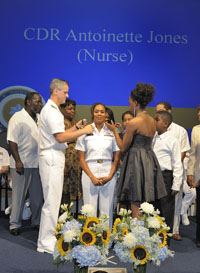 |
|
CDR Antoinette L. Jones, deputy chief, CC Office of Workforce Management and Development, smiles as RADM Dr. David Rutstein and her daughter Daishyana change her boards.
|
 |
|
LCDR Rachael Drabot was promoted in the US Public Health Service Commissioned Corps by Acting Deputy Surgeon General RADM Dr. David Rutstein (left) and her fiancé Ed Lopez.
|
The US Public Health Service—which protects, promotes, and advances the health and safety of the nation—saw the promotion of 38 NIH employees in the Commissioned Corps in July.
"NIH is really about turning discovery into health. This is our battlefield," said RADM (ret) Dr. Richard Wyatt, deputy director of the NIH Office of Intramural Research.
In his remarks, Acting Deputy Surgeon General RADM Dr. David Rutstein told those present in Masur Auditorium, "It is a true honor to be among these officers who have stood out among their colleagues."
The 38 NIH USPHS officers were promoted with the changing of shoulder boards to denote their new positions.
Celebrating the honor were:
Medical Officers: CAPT Stephen Migueles, CAPT Darrell Singer, LCDR Christopher Ramsden
Dental Officer: CDR Demetrio Domingo
Nurse Officers: CAPT Martha Marquesen; CAPT Lisa Marunycz, CDR Linda Ellison-Dejewski, CDR Geri Hawks, CDR Antoinette Jones, CDR Jacquin Jones, CDR Sophia Russell, CDR Margarita Velarde, LCDR Shu Cai, LCDR Jeanne Chamberlain, LCDR Lindia Engram, LCDR Stefanie Glenn, LCDR Andrew Keel, LCDR Karen Livornese, LCDR Katherine Maye, LCDR Kala Rochelle, LCDR Leorey Saligan, LCDR Jennifer Sarchet, LCDR Latoya Sewell, LCDR Phoebe Underwood-Davis
Scientist Officers: CAPT Steven Sparenborg, CDR Sally Hu
Environmental Health Officers: CDR Jason Barr, CDR Mark Marshall, LCDR John McLamb
Pharmacy Officers: CAPT Paul Na, CDR Luke Park
Dietitian Officer: LCDR Rachael Drabot
Health Services Officers: CDR Debra King, CDR Claudine Samanic, LCDR Christina Coriz, LCDR James Pitt, LCDR Janet Valdez, and LT Garman Williams
New call-to-active duty officers and newly retired officers were also noted at the event.
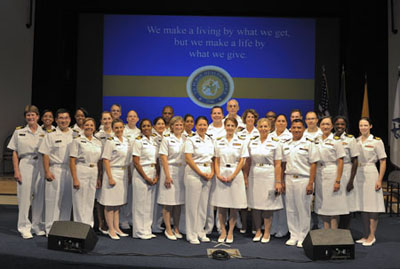 |
|
The US Public Health Service saw 38 officers celebrate a rank promotion at a ceremony in the Clinical Center Masur Auditorium in July.
|
Back to Top
Microbiology assistant chief retires after 34 years
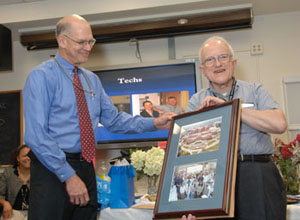 |
|
Dr. Frank Witebsky (right) was acknowledged by staff including Dr. Thomas Fleisher, chief of the Department of Laboratory Medicine, for his years as assistant chief of the department's Microbiology Service at his retirement party in August.
|
At more of a "transition" than retirement party, long-time assistant chief of the Microbiology Service in the Department of Laboratory Medicine (DLM), Dr. Frank Witebsky was honored August 3 by friends and colleagues, some returning to the Clinical Center just for the occasion.
Witebsky, originally trained as a psychiatrist, joined the NIH as a resident in the National Cancer Institute Laboratory of Pathology in 1972. After a clinical pathology residency in DLM, he became assistant chief of the Microbiology Service in 1976.
"This has been much more than just a place to work," Witebsky said. "It is as much my home as my house."
After a trip to Colombia, South America, where he'll enjoy his beloved past-time of bird-watching, Witebsky will begin the next phase of his career as a volunteer in DLM.
At his retirement celebration, peers and mentees from his 36 years with the department gathered to tell Witebsky how much he impacted their lives. Patti Conville, his research technologist for 24 years, called him a "wonderful mentor, kind boss, and good friend."
Dr. Thomas Fleisher, chief of the DLM, presented Witebsky with a frame of photos of the CC and the Microbiology Service staff.
"I've made some wonderful friends here and had a wonderful time almost all of the time," Witebsky said.
Back to Top
NIH staff care for patient caregivers with Family Lodge dinners
 |
|
3NW staffers, including (from left) Candace Cottle with daughter Mikayla, Sue Johnson, Sara Kullman, and Sandra Cooper hosted a Family Lodge dinner in July.
|
The stress of a sick loved one and an extended stay in an unfamiliar place can make mealtime difficult for patient caregivers.
Two groups of NIH employees have helped patient family members by donating food and time to host dinners at the Edmond J. Safra Family Lodge in July.
The Bethesda Medical Chapter of the National Contract Management Association hosted its second annual summer cookout at the lodge. Celebrating the Family Lodge's fifth anniversary and the nation's birthday, the association members grilled hamburgers and hotdogs and served salads and iced tea. They also host a chili dinner in the winter.
It can be hard to navigate to a restaurant or grocery store without a car or prior knowledge of the transit system, said Henry Primas of the Clinical Center Office of Purchasing and Contracts. He said his group is happy to do something for the community and help make life a little easier for CC patient family members.
Sandra Cooper, a nurse on 3NW, rallied her coworkers to bring chicken, rice, salads, and dessert to the Family Lodge.
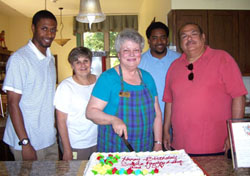 |
|
Margo Bradford, Family Lodge operations manager, cuts a cake with NCMA members (from left) Raymond Hawkins, Toni Kruzic-Ager, Ryan Singletary, and Henry Primas at a cookout the association hosted.
|
"You have to take care of the caregiver," said Cooper, who noted that some patients on her medical oncology unit stay for weeks at a time.
Margo Bradford, Family Lodge operations manager, wrote the nurses a letter of thanks. "When each of you already has a full plate, work-wise, it is truly wonderful that you could add this good deed into your lives! I can assure you that everyone who came to the kitchen in anticipation of finding a meal was so happy with the delicious and varied choices you brought to the Family Lodge. Many called it a feast!" she said.
Cooper started a food drive for the Family Lodge and plans to host more dinners in the future. She encourages other units to consider organizing an event for the Family Lodge, too.
"It doesn't take much to host a dinner especially with so many cooks in the kitchen," she said.
If interested in volunteering to host a dinner at the Family Lodge, contact Bradford at mhbradford@cc.nih.gov.
Back to Top
Principles and Practice of Clinical Research course registration open
Registration for the 2010-2011 "Introduction to the Principles and Practice of Clinical Research" course is now open. The course will run from October 18 through March 9, 2011.
This course will be of interest to physicians and all health professionals planning a career in clinical research and who are members of clinical and translational research teams. Participants can expect to become familiar with epidemiologic methods involved in clinical research and with the principles and issues involved in conducting and monitoring patient-oriented research. Also covered in the course are the ethical and legal issues of clinical research; the regulations involved in human subjects research, including the role of the institutional review board; the infrastructure required in performing clinical research; and the steps involved in developing and funding research studies.
Classes will be held in the Clinical Center's Lipsett Amphitheater on Monday and Tuesday evenings from 5:00 pm to approximately 6:30 pm. There is no charge for the course; however, the textbook Principles and Practice of Clinical Research, Second Edition is suggested as supplemental information for the course. A certificate will be awarded upon successful completion of the course, which is based on passing a final examination.
Approximately 1,300 students registered for the 2009-2010 course, which was also broadcast in real time to 21 domestic and international locations and was web-based at four locations. A modified version of the course was taught live in Ibadan, Nigeria in May.
For additional information or to register, please visit the course website at http://www.cc.nih.gov/training/training/ippcr/application.html or call the CC Office of Clinical Research Training and Medical Education at 301-496-9425. The deadline for registering is October 8, 2010.
Back to Top
Nurses present on tribal community's role in research development
Clinical Center Nursing and Patient Care Services and nurse leaders from the Indian Health Service (IHS) organized a symposium and workshop utilizing principles of community-based participatory research on the Fort Belknap Indian Reservation in 2009. Recently NIH, IHS, and Fort Belknap representatives presented outcomes from those events.
At the 2010 Nurse Leaders in Native Care Conference held in DC in July, Kathleen Adams, manager of public health nursing, Fort Belknap Tribal Health, and Desiree Goodman, director of nursing, Fort Belknap Service Unit, presented a poster and led a discussion on Utilizing Community Based Participatory Research Principles as a Mechanism for Delivery of EBP in Tribal Communities: Fort Belknap Research Symposium and Evidence-Based Practice Workshop.
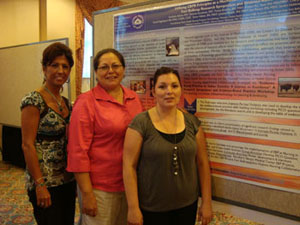 |
|
Presenting at the 2010 Nurse Leaders in Native Care Conference in July on their experience with community-based participatory research were (from left) Desiree Goodman, director of nursing, Fort Belknap Service Unit; Teresa N. Brockie, Clinical Center research nurse specialist; and Kathleen Adams, manager of public health nursing, Fort Belknap Community Council.
|
Community-based participatory research is a collaborative approach that involves tribal communities in knowledge generation, intervention research, and policy change. Evidence-based practice is a problem-solving approach to the delivery of health care that integrates the best evidence from research with a clinician's expertise and a patient's or a community's preferences and values.
The research symposium informed practitioners of significant research findings related to community–identified health topics of concern (community and family violence, methamphetamine abuse, mental health, and suicide). The interactive workshop facilitated and encouraged the implementation of evidence into practice.
The presentation at the July conference provided the process of collaboration—from initiation to the culmination of the research symposium and workshop—using a community-based participatory research model for Native American community engagement.
Through continued collaboration with the CC, Fort Belknap nursing is utilizing the process to develop a project focused on adolescent alcohol use, with an implementation date of April/May 2011.
Adams and Goodman spent a day at the CC while in the area. They held project develop meetings with nursing research staff and clinical nurse specialists and toured the hospital.
Back to Top
Nursing summer students form diverse group
Clinical Center Nursing and Patient Care Services (NPCS) hosted a group of 2010 summer students from universities around the country.
Top row, left to right, are Justine Garofalo (Clemson University), Morgan Whetstone (University of Maryland, College Park), Katie Erichsen (Seattle Pacific University), Alyssa Todaro (Pennsylvania State University), Stephanie Perry (Towson University), and Sheila Prados (University of New Mexico).
Middle row, left to right, are Anthony Valloric (University of Maryland, Baltimore), Michael Sheer (Molloy College), Logan Kolakowski (Wake Forest University), Brendan Cusack (University of Maryland, College Park), Rebecca Berger (University of Pennsylvania), and Madeleine Williams, NPCS nurse consultant and summer student program coordinator.
Bottom row, left to right, are Megan Fauci (Columbia University) and Megan Hohenstein (University of Tampa).
Not pictured are Brittany Bryant (Hampton University) and Tonya Jenkins (Towson University).
Back to Top
Bedside-to-Bench Program accepting 2011 proposals
Originally established in 1999 to integrate the work of basic and clinical scientists on the NIH campus, the Bedside-to-Bench Program expanded in 2006 to encourage partnerships between intramural and extramural investigators.
To date, about 600 principal and associate investigators have collaborated on 176 funded projects with approximately $40 million distributed in total Bedside-to-Bench funding.
The 2011 call for proposals has been posted and letters of intent must be submitted electronically no later than September 22.
For the first step in the application process, the NIH intramural investigator must submit a letter of intent (LOI) electronically via proposalCentral. LOIs are reviewed by the scientific director for each intramural investigator on a project and allow an opportunity to advise principal investigators regarding the proposal prior to formal submission.
For more information, visit www.cc.nih.gov/ccc/btb/.
Back to Top
Transfusion Medicine symposium informs on latest in field
The Clinical Center Department of Transfusion Medicine and the American Red Cross will host the 29th Annual Immunohematology & Blood Transfusion Symposium on September 16 in the CC Masur Auditorium.
Developed to inform about recent developments, current practices, controversies, and laboratory management issues relative to transfusion medicine, the event will be of interest to health-care providers who work with blood products.
Topics to be covered include:
- the impact of malaria deferrals on blood availability,
- current FDA research on diagnostic technologies and methods to predict blood product safety and efficacy,
- benefits of and lessons learned from the National Hemovigilance Network,
- and application of genotyping in both clinical and donor settings.
Registration is free and on-site. For more information, visit http://www.cc.nih.gov/dtm/research/symposium.html.
Back to Top
Clinical Center Grand Rounds
Lipsett Amphitheater, 12 noon
Lectures will be videocast at http://videocast.nih.gov.
September 1
Diabetes Risk in the Workplace: NHLBI's "Keep the Beat" Worksite Wellness Program
Richard O. Cannon III, MD
Clinical Director, NHLBI
Heart Disease: Risk Factors and Race
Anne E. Sumner, MD
Tenure-Track Investigator, Clinical Endocrinology Branch, Division of Intramural Research, NIDDK
September 8
Contemporary Clinical Medicine: Great Teachers
Transplantation Neurology: An Evolving Spectrum of Diagnostic Dilemmas
Amy A. Pruitt, MD
Associate Professor of Neurology, Department of Neurology, University of Pennsylvania School of Medicine
September 15
Developing New Therapeutic Strategies for Severe Asthma
Stewart J. Levine, MD
Chief, Laboratory of Asthma and Lung Inflammation, Pulmonary and Vascular Medicine Branch, NHLBI
Systemic Capillary Leak Syndrome (Clarkson's Disease)
Kirk Druey, MD
Chief, Molecular Signal Transduction Section, Laboratory of Allergic Diseases, NIAID
September 22
Sequencing Human Genomes Circa 2010
Eric Green, MD, PhD
Director, NHGRI
Clinical Annotation of Genomes: Challenges and Opportunities
Leslie Biesecker, MD
Chief, Genetic Disease Research Branch, NHGRI
September 29
Changing Cancer Diagnosis and Treatment Using Genomics
Louis M. Staudt, MD, PhD
Deputy Chief, Metabolism Branch, Center for Cancer Research, NCI
Wyndham Wilson, MD, PhD
Senior Investigator and Chief, Lymphoma Therapeutics Section, Metabolism Branch, Center for Cancer Research, NCI
Back to Top
This page last updated on 12/18/2017


 The information on this page is archived and provided for reference purposes only.
The information on this page is archived and provided for reference purposes only.